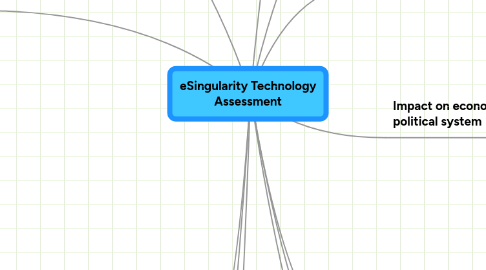
1. Intention of this map
1.1. Why should eSingularity be assessed?
1.1.1. feasability (can it be done starting with the tech level of today or is it a 2030 thing?)
1.1.2. better understanding of overall concept and architecture
1.1.3. better understanding of components
1.1.4. better understanding of benefits, costs, risks and chances
1.2. TA will result in ...
1.2.1. advantages for the development process
1.2.1.1. clarity in roadmap construction
1.2.1.2. setting priorities
1.2.2. advantages for spreading the idea to
1.2.2.1. individuals
1.2.2.1.1. (make it more attractive and viral)
1.2.2.2. interest groups
1.2.2.3. thought leaders
1.2.3. advantages for finding partners and allies
1.3. What should be assessed?
1.3.1. feasability
1.3.2. impact on economical and political system
1.3.3. impact on geopolitical system
1.3.4. note: this is a start - with the ongoing process the range of TA can change
1.3.5. impact on current global education system
1.3.6. impact on cultures
1.3.7. remind wild cards and black swans
2. What is Technology Assessment?
2.1. Technology assessment - Wikipedia http://en.wikipedia.org/wiki/Technology_assessment
2.2. Complementary approach is to make foresight a multplayer game: Gaming the future
2.2.1. http://www.superstructgame.org/
3. Impact on education system
3.1. impact on current global education system
3.2. change of methods
3.3. teachers
3.4. institutions teaching teachers
3.5. qualification levels
4. Impact on economical and political system
4.1. labor market
4.1.1. eS ending in over-qualification?
4.2. industry
4.2.1. delivering textbooks, selling eLearning
4.2.2. protecting the value chain against freeconomics
4.3. regions+nations
4.4. politics
4.4.1. promoting democracy, self-esteem, participation, responsible living
4.4.2. e.g. destabalizing power structures built on knowledge asymmetry?
4.4.3. promoting value of freedom and individualism? hyper competition?
4.4.4. hyper acceleration of technological progress
4.4.5. legal issues, copyright
4.5. economy
4.5.1. new value chains?
4.5.2. innovation and knowledge economy
4.5.3. desirability? econonomical rationality?
4.6. scenarios
4.6.1. hyper competition scenario
5. Impact on cultures
5.1. learning cultures
5.1.1. Social Assessment - power shift away from teachers to "learning spaces of experience"
5.2. value system, traditional cultures
5.2.1. there is an optimistic, modernist assumption in the eS vision: enlightenment of the planet means less conflict and more prosperity
5.2.2. humanizing effects of technology
5.2.3. dehumanizing effects of technology
6. Feasability
6.1. maturity of infrastructure
6.2. roadmap of components
6.3. other technological conditions
7. Impact on geopolitical system
7.1. Accelerated Power Shift to Asia?
7.2. digital divide because of insufficiant means of purchasing in Africa, India and China?
8. Impact on ecological system
8.1. secondary effect of economical development is intense metabolism, accelerated consumption of natural ressources
9. Ring of maps
9.1. Learniing 3.0 Mind Map https://www.mindmeister.com/26144574
10. Author of this map
10.1. I am Willi Schroll, a technology analyst, strategy consultant and futurist. See more about me here: http://www.linkedin.com/in/willischroll or on this mind map: Learniing 3.0 Mind Map https://www.mindmeister.com/26144574
11. Possible deficits of the current vision
11.1. lack of scope
11.1.1. the learning system vision up to now looks rather behavioristic
11.1.2. to implement an "addictive" system might be an ambivalent goal at leat
11.1.3. where is the place and role of social learning, emotional intelligence, empathy?
11.1.4. where is creativity?
11.2. counter measurement: remind these insights of some experts
11.2.1. Howard Gardner
11.2.1.1. Howard Gardner has shown that there is a multitude of intellgences
11.2.1.1.1. Gardner's five minds—disciplined, synthesizing, creating, respectful and ethical—are not personality types, but ways of thinking available to anyone who invests the time and effort to cultivate them: “how we should use our minds.” - 2006
11.2.1.1.2. Link
11.2.1.2. Gartner ... perceives human mental endowment as an assemblage of fairly autonomous ""frames of mind,"" or multiple intelligences: linguistic, musical, logical-mathematical, spatial, bodily-kinetic, and a category Gardner calls ""personal intelligences""--meaning both intrapersonal and interpersonal.
11.2.1.3. Neue Idee
11.2.2. Daniel Goleman
11.2.2.1. Ecological Intelligence
11.2.2.2. Emotional Intelligence
11.2.2.3. Social Intelligence
11.2.2.4. Books http://www.danielgoleman.info/blog/purchase/
11.2.2.5. http://www.danielgoleman.info/blog/
11.3. deficits could lead to
11.3.1. low interest of potential partners in academies and economy
11.3.2. low adoption rates (afer realization)
11.3.3. low success rates of students
12. What is eSingularity?
12.1. find answers one level up on the: Learning 3.0 Mind Map https://www.mindmeister.com/26144574
12.2. related and similar projects
12.2.1. http://www.ahumanright.org
12.2.2. ahumanright.org wants a 16 satellite network, bringing broadband inet access to rural areas worldwide for 1.7b usd 3:33 AM Nov 23rd 2009 http://twitter.com/tripleseven/status/5974062945
12.2.3. WE BELIEVE THAT ACCESS TO COMMUNICATION IS A HUMAN RIGHT
12.2.4. WE ARE BUILDING A FREE COMMUNICATION NETWORK AVAILABLE ANYWHERE IN THE WORLD
